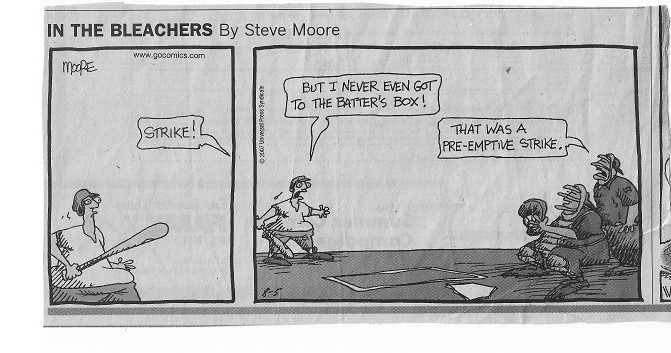Some of the following information is taken from Referee.com article 1/22/19
Softball is played without a clock but increasing game times are very much on the minds of many involved with overseeing the game, particularly at those upper levels where television contracts and drawing fans into seats are big concerns. For a game that does not run on a clock, softball is a game that benefits from a certain pace of play. Not that it needs to be rushed, but there is both game time and dead time that needs to be managed better. And, as umpires, we’re not getting paid by the minute.
Game flow
Good game flow comes from being aware of what is happening, using the rules we have been given to manage a good pace of the game, and applying them with common sense. A game with good flow has these characteristics:
• Game moves along, few delays
• Stays on schedule
• Players playing, hustling onto / off of the diamond
• Pitchers working ahead of batters primarily
• Hitters swinging the bat, not “taking” too many pitches
• Fielders making the plays, few or no errors
• Good ball rotation (on balls hit out of play, etc.)
Managing the game flow
This involves knowing over what you have control and what is out of your control.
An umpire can control:
• Game ball rotation
• Conference length
• Comportment
• Efficient coach interaction
• Rule & Mechanics Knowledge
• Umpire-to-Umpire non-verbal communication
Out of our control:
• Numerous walks, hits and errors, runs.
• Pitching accuracy
• Weather
• Field issues
• Substitutions, pitching changes
Tools we have for game flow
• A few rules – pitcher’s time between pitches, warm-up pitches allowed, batter in box, no huddle defense, Media format when used in the game, assistant coaches nor permitted to argue…
• Warnings regarding questions on strike zones and judgement calls
• Managing delays, awareness
• Our own demeanor, presence, focus and hustle
Play: The defense asks one of the base umpires for time to speak to one or more defensive players, which is granted. (This will now be a charged player-to-player conference, per the 2022-2023 rule book) The plate umpire is not dealing with any substitutions or anything else. Who should be the responsible umpire to break up the conference – the umpire that granted the time out or the plate umpire? We have had a difference of opinions on this when it happened in a game.
Official interpretation issued by Craig Hyde, NCAA Softball National Coordinator: If players are near the plate, dugouts or circle, plate can break the communication; if near the base umpires – the one in the vicinity can break up.
The strike zone is not usually included in conversations about game flow. Yes, we want to be aggressive on our strike zone but the meaning of this “aggressive” is:
• Not to call strikes on pitches outside the zone, But
• To NOT miss the strikes that are at the perimeters of the zone.
Set the tone early and get the hitters swinging on pitches that graze the outside limits of both the vertical and horizontal zone. However, do not use this technique on the first batter of the game to set the tone:

From Referee.com (some items already mentioned above)
Remain diligent to keep the game moving
While there are many things outside the control of umpires, there are matters under the rules upon which umpires should remain diligent to keep the game moving appropriately. These include:
- Enforce the time limits between half-innings if appropriate. Count the pitches and let the catcher know, “Catcher, one more and then take it down.” Show how many more pitches to the pitcher and on-deck batter, so everyone knows to be ready in two pitches.
- Don’t wait until you run out of softballs to alert a coach or attendant that you’re low.
- Make sure batters are staying close to the box and they know you have the 10-second clock going. Making them aware that you will call a strike tends to solve the problem.
- Show some hustle. Jog back to the plate after breaking up a conference at the mound. (And don’t let those conferences stretch endlessly; break them up after a reasonable time.) As the base umpire, after the third out, jog out to your between-inning spot in the outfield. Being a model for hustle will often inspire players to show a little hustle themselves — they don’t want to seem slower and less inspired than the umpires.
- Sneak a peek. Plate umpires are often trailing the batter-runner, or moving toward the circle, or getting to the holding area, or taking a play at 3b. When walking back toward the plate at the conclusion of the play, take a look at the coach’s box and/or dugout to see if a coach is heading your way with their lineup card.
- Between innings, do not get together needlessly with your partner(s). Count the warmup pitches and get the game moving. If the plate umpire needs to take a substitution, the base umpire should count the pitches and flash the number remaining (or whatever prearranged signal was worked out before the game, such as a winding of a finger) once the plate umpire is done noting the lineup changes.
- At levels where stopwatches are required, make sure they’re not forgotten in an equipment bag.
- Enforce the rules regarding time to deliver pitches. Know the 10-10-5 rule, manage it with common sense, know when to apply it, and be ready with a good explanation for the ensuing argument, which must be very short.
Innings may not run on a clock, but the game benefits from moving along at a certain pace. Umpires should make sure they’re enforcing the rules that help keep that pace going.
